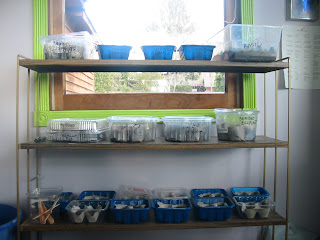We are SO lucky to have the Sow True Seed Company in our town! I wanted to share this piece with you that was published in their most recent mailing. This local seed company ships around the country...so if you are not able to come visit them in Asheville, you can still have their wonderful seeds and support a business that has as their goal the best interests of our planet and our health!
We Step Up to Say NO to GMO
On March 29, 2011, Sow True Seed joined 60 family farmers, seed businesses and organic agricultural organizations to file suit against Monsanto Company to challenge the chemical giant's patents on genetically modified seed. Once released into the environment, genetically modified seed contaminates and destroys naturally reproducing seed for the same crop. For example, soon after Monsanto introduced genetically modified seed for canola, organic canola became virtually extinct as a result of cross-contamination. Organic corn, soybeans, cotton, sugar beets and alfalfa now face the same fate, as Monsanto has released genetically modified seed for each of those crops, too. Monsanto is developing genetically modified seed for many other crops, thus putting the future of all food, and indeed all agriculture, at stake.
“It is challenging to find non-hybrid (open-pollinated) corn seed that has not been contaminated by genetically modified pollen,” says Sow True Seed Co-Founder Peter Waskiewicz. “We choose to test our corn seed to ensure it is free of GMOs before we offer it to our customers. In the last decade, it’s become nearly impossible to ensure corn seed is free from contamination.”
“We never planned to become involved in a lawsuit, but morally it has become necessary to stand up and fight for keeping open-pollinated seed safe and available,” says Co-Founder Carol Koury. “Sow True Seed was founded to promote and foster sustainable regional agriculture by helping to preserve our shared botanical heritage and seed a new era of sustainable culture and ecological wisdom. Monsanto not only does not embody this vision, but is actually encroaching on our ability to offer open-pollinated and organic seeds. We are fighting against this injustice.”
Waskiewicz adds, “We recognize that the unlimited production and distribution of open-pollinated seed is primary to the growth and endurance of sustainable, regional farming communities. Sow True Seed endorses the basic right of all the earth’s people to enjoy a safe, ethical and sovereign food production and distribution system.”
For more information, please visit: http://www.pubpat.org/monsanto-seed-patents.htm
To get involved:
- Sign the MILLIONS AGAINST MONSANTO petition in support of GMO labeling at: http://organicconsumers.org/monsanto/index.cfm
- Sign the Food Democracy NOW! letter to the Department of Justice to break up Monsanto at: http://action.fooddemocracynow.org/sign/break_up_monsanto/
- Support local agriculture - join local groups that advocate for healthy, organic, locally grown and produced products like ASAP (Appalachian Sustainable Agriculture Project)







 The Pearson Drive Garden is the Bountiful Cities Project's model garden. It is over an acre of land that produces edibles for the community. We grow a diverse selection of vegetables, including a wide range of greens and peas in the spring, tomatoes, squash, potatoes, and pumpkins in the summer. There is some vegetable production throughout the year, as we grow cold tolerant vegetables under row covers.In addition to the traditional garden vegetables, we grow wild greens, culinary and medicinal herbs, and some perennial vegetables, like the Jerusalem artichoke. Fruits grown at the Pearson Drive Garden include strawberries, raspberries, and apples.
The Pearson Drive Garden is the Bountiful Cities Project's model garden. It is over an acre of land that produces edibles for the community. We grow a diverse selection of vegetables, including a wide range of greens and peas in the spring, tomatoes, squash, potatoes, and pumpkins in the summer. There is some vegetable production throughout the year, as we grow cold tolerant vegetables under row covers.In addition to the traditional garden vegetables, we grow wild greens, culinary and medicinal herbs, and some perennial vegetables, like the Jerusalem artichoke. Fruits grown at the Pearson Drive Garden include strawberries, raspberries, and apples. 
















